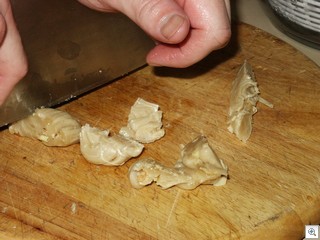During the last week or so most of our home meals have been minor variations of things I’ve made recently, and on late nights, arriving home quite hungry, I haven’t felt much of an urge to photograph the “reruns.”
Tonight, though, I made a first attempt at a brown nougat, made without egg whites, flavored with a bit of kirsch and vanilla. I embedded some almonds in the nougat. My hands weren’t quite happy, because I worked the sugar while it was still hot enough to produce some blisters on my hands. The Silpat mat helped me rein in the sugar as it started cooling initially, but I wanted to incorporate some air into the candy.
The shiny stretched sugar mass
Cutting the nougat into bite-sized bits
I should have used a lower final temperature when I boiled the sugar mass. I got a fairly crunchy-chewy result; I really would have been happy if it were merely chewy.
Dusted with cornstarch
I dusted the candy with cornstarch so that I can store it without the pieces sticking together. The end result isn’t bad, but I think I have to experiment a bit more before I develop much confidence in candy-making.
I finally got around to shooting some photos of Masa and Lisa’s Matcha White Chocolates, a product that evolved from a promotional concept I developed back in the late spring or early summer. After months of struggling with packaging options and some variations of recipes, they got the chocolates ready just about a week before Christmas, and we got it into the hands of a few customers before the holidays, but we will probably mostly be promoting the product leading up to Valentine’s Day.
Alas, I wasn’t quite happy with my own photographs tonight, so I’m continuing to borrow some of Masa’s and Lisa’s for my YuzuMura project.
Hiromi says that she can’t readily find matcha chocolates of this quality in Japan… most of the Japanese products I’ve seen so far use a fairly low grade of matcha and a blend of other ingredients to simulate the matcha… Masa and Lisa decided to use the same matcha they use to produce their matcha latte, so it’s a fairly nice result. I’ve gone with a somewhat more assertively matcha-y flavor profile in my own matcha white chocolate enrobed fortune cookies, so their chocolates have a slightly sweeter touch than my cookies, but I like them as a small indulgence, so the sweetness isn’t terribly overwhelming. The little foil packets help me with portion control…












